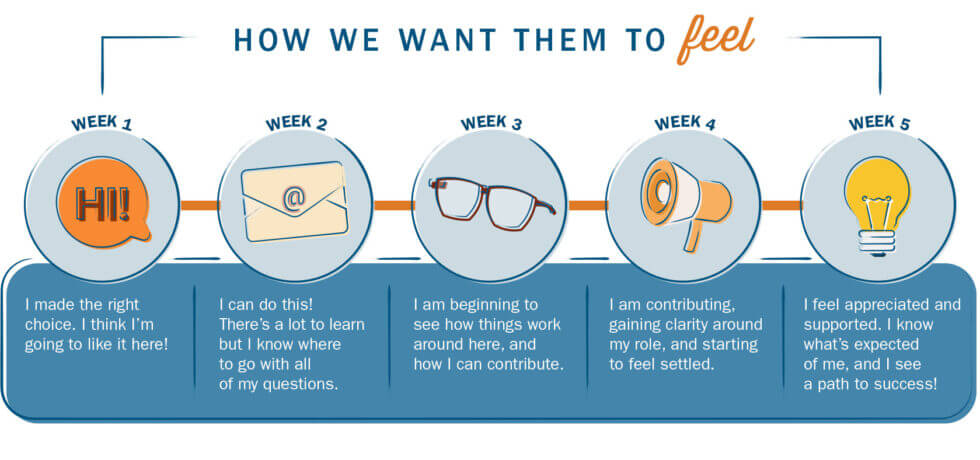
This article originally appeared in the Onboarding Matters Issue of Performance Matters. View the digital magazine.
Technology surrounds us. Yet interacting with technology often is a cold, transactional experience. What if we could use onboarding technology to enable interaction and enhance the human experience of onboarding?
Most organizations use technology as part of the onboarding experience. We fill out forms, consume eLearning, and consume internal resources. We use software and devices to deliver and store content. But what story will a new employee tell about their experience? How does using onboarding technology help people perform better and be more productive faster?
In many cases, we have a bunch of content, but the content experience is organized like a scavenger hunt. We send new employees on a quest to find information, but at each stop we change the context for why they’re there. Go to the LMS for this, go to the CRM for that, check the HR intranet page, etc. It isn’t consistent, and worse, it dilutes what we’re trying to achieve with onboarding.
At the end of the day, you may have checked off all the boxes, but the journey wasn’t memorable and may have left the user feeling confused and frustrated. And it’s not enough to change the window dressing if you don’t also address the underlying content and experience challenges. Otherwise all you have is a sleek but impractical interface that leaves employees feeling just as irritated.
Once you’ve reimagined the onboarding experience and can tell the story from preboarding through the first weeks and months, it’s time to use onboarding technology to help tell that story.
To shift our thinking on onboarding technology, we have to start looking at the context of the provided content. Think of it as a personalized employee dashboard that’s all about that new person, their mindset, and what they need to succeed within your company.
This includes transactional tasks (e.g., paperwork), but also what they need to know about the company, the function, and role they were hired to perform.
Too often we place all the focus only on what we need new team members to learn or complete for compliance purposes. Yet, when we focus on their needs and acclimating them to the company, their role, and the tremendous value they bring, we make them feel like they belong. Try reframing the context to be about how we want them to feel.

Once you set the context, you can structure the knowledge and experiences you need them to have in the onboarding journey. Use the context to design the perfect first day and week that would be a great experience and story to tell. Design it so they know exactly what they’re supposed to do and what’s coming next.
There should always be a logical connection between one experience and the next. It’s not about making an interactive checklist; it’s about imagining what your new hire is going through and trying to meet them there—addressing their anxiety, curiosity, and the significant things that happen to them along the way.
Onboarding technology like web portals can enable these kinds of experiences in a systematic way:
This is all great stuff! But the onboarding technology isn’t the experience itself, it just supports the experience.
Think about the collection of experiences on your onboarding path. What are the most important and meaningful in the journey?
Now think about how the new employee experiences those things. Was it an eLearning module or a human exchange? Did they research a product on your intranet, or did they reach out to a coworker to ask them how they sell it?
Finally, think about how you can incorporate human-based moments of meaning into the experience.
One of my favorite onboarding experience stories involves a client who distributed free reusable water bottles to all employees. They could have just placed the water bottle on the new hire’s desk on the first day, but instead they decided to make getting the water bottle a learning experience. The onboarding portal told the new employee who to find, gave them a few personal questions to ask before they could pick up the bottle, and shared why the company valued reusable water bottles. A simple task became something personal and meaningful.
The technology wasn’t the focus, but it prompted the action. It provided a framework and context around a human-centered event that became part of the overall experience.
The goal isn’t necessarily to have the flashiest and fanciest onboarding technology; it’s to design the best experience with the best usability for a new employee. Create something where the onboarding process is personalized, clear, easy, and intuitive. Make the technology irrelevant and the experience the star of the show.
Use onboarding technology to highlight meaningful human experiences and you’ll be well on your way to making your onboarding a more effective and memorable journey that accelerates a new hire’s time to competency.
Want to connect with TiER1 to reimagine your onboarding experience? Drop us a line below.